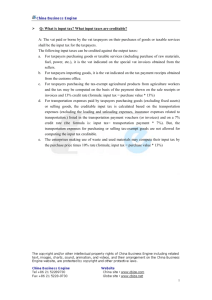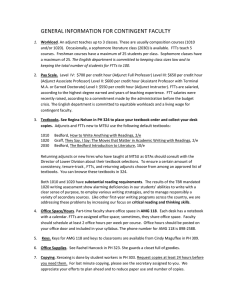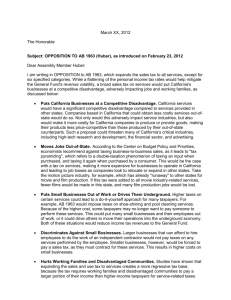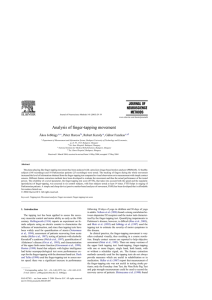Options in tax policy and administration for the financial
advertisement
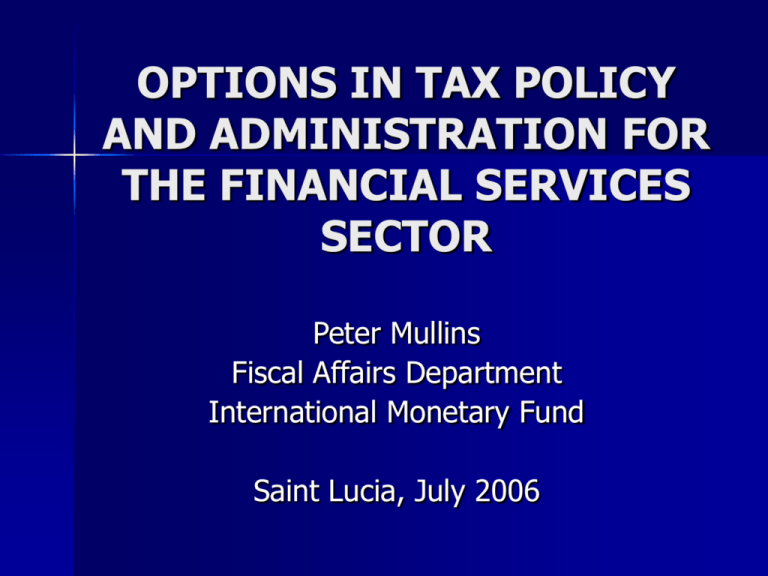
OPTIONS IN TAX POLICY AND ADMINISTRATION FOR THE FINANCIAL SERVICES SECTOR Peter Mullins Fiscal Affairs Department International Monetary Fund Saint Lucia, July 2006 Overview Background on the financial services sector and tax policy design Some topical issues: – VAT and financial services – Financial transaction taxes – Regional Tax Co-ordination – Flat tax Size of the financial services sector in the Caribbean The sector is significant: – 1000 offshore banks, 1200 insurance companies and 5000 mutual funds (2000/01) – Annual fees from the sector raise 3.4% of government revenue (average for ECCU countries) – Significant source of corporate tax revenues – e.g., 40% in Barbados (2000) Considerations in tax policy design for the sector Policies should satisfy tax principles of equity, simplicity and efficiency ... which means avoiding distortions both: – within the sector – between different institutions or financial products; and – with other sectors – sector is prone to seek and often get preferential treatment ... this can lead to: Inefficient allocation of resources to the sector; and Tax arbitrage VAT and Financial Services What is the problem? Financial services are of many different kinds: – Fee-based, such as safe-keeping or ATM transactions – Asset management – Intermediation between borrower and lender – Insurance Fee based services can usually be measured Problem is with intermediation services as ... price charged for these services often implicit rather than explicit Example Bank borrows at 5%, lends at 15% So value of services is given by the margin (10%) But how much of this goes to borrower and how much to lender? Difficult to apply standard invoice-credit method Options for VAT on financial services 1. 2. 3. 4. 5. 6. Basic exemption Exemption with input credits Zero-rating business to business Taxing gross interest Addition method Cash-flow approach 1. Basic Exemption Most common practice/advice – used by EU: – Fee-based services fully taxed – Other financial services exempt (except when exported which are zero-rated) Taxes some financial services thereby increasing revenues and reducing cascading But exemption of financial services gives a range of problems: – Need to apportion inputs between exempt and taxed (including zero-rated) outputs – leads to arguments between taxpayers and authorities – Incentive to self-supply – Cascading EU currently reviewing basic exemption approach 2. Exemption with input credits Credit for tax on inputs used to provide services to registered taxpayers by using a fixed percentage Singapore – percentage based on industry and type of institution Australia – 75% of input tax Overcomes some cascading 3. Zero-rating business to business Credit for tax on inputs used to provide services to registered taxpayers by specifically identifying taxpayers New Zealand uses this approach – credit only if registered taxpayer satisfies a taxable sales threshold Overcomes some cascading ... but requires financial institution to identify registered taxpayers and whether they satisfy the threshold 4. Taxing gross interest Levy VAT on gross interest on loans Business borrowers claim credits but financial institution cannot Problems: – Cascading – Tax on both cash price and financing Argentina uses this approach – taxes at half standard rate (10.5% rather than 21%) due to problems 5. Addition method VAT levied on sum of wages and profits (as proxy for value add) Simple method used in Israel Problems: – Cascading – Does not fit well with invoice-credit method as not on a transaction by transaction approach 6. Cash flow approach As yet untried method - Treat all cash inflows as sales, hence taxable; treat all outflows as purchases, hence creditable Taxes value added by financial institution but: – likely to cause cash flow problems to businesses (due to tax on loans which are not offset until repayment), and – Difficult transitional issues with existing loans Conclusion No perfect solution But may be benefits for Caribbean countries in taxing the sector as it: – Removes distortions – Raises much needed revenue Financial Transaction Taxes Types of FTTs Stamp duties Turnover taxes Taxes on bank deposits and withdrawals Insurance premium taxes Tobin taxes – i.e., taxes on foreign currency Advantages & Disadvantages of FTTs Advantages: – Raise significant revenue in short term Disadvantages: – FTTs are distortionary – Contribute to financial disintermediation – i.e., financial transactions by-pass the financial sector ... which leads to ... – Loss of revenue in medium term – from disintermediation and decrease in corporate profits International Trend for FTTs Trend is to move away from FTTs and rely on less distortionary taxes such as VAT Conclusion is that FTTs useful in times of fiscal crisis as a simple means to raise revenue but ... should only be introduced for a short period to be replaced by less distortionary taxes Regional Tax Coordination Why coordinate? Proposed move to a single financial space in the region by removing cross-border restrictions – tax coordination supports such a move Avoids arbitrary distortions between countries due to different tax systems ... especially for the financial services sector Danger of ‘race to the bottom’ – cuts in rates or erosion of base (e.g., through incentives) leaves rates and bases too low in the collective interest International practice EU Code of Conduct – non-binding coordination where members agree to rollback existing measures, and not introduce new measures which affect location of investment OECD Harmful Tax Practice Project Central America Project Working group on tax coordination in Central America and Dominican Republic (with support from IMF, IADB, World Bank) Principles: – Protect tax base and strengthen the tax systems – Maintain a friendly tax environment for investment – Avoid tax discrimination and tax competition – Respect national sovereignty Central America Project Preparing: – a code of conduct on tax incentives for investment – includes criteria for tax incentives – Regional model double tax treaty Work still in progress but may provide model for the Caribbean Flat Tax What is the flat tax? Classic Hall-Rabushka flat tax is single rate tax on wages and a cash-flow tax on business income all levied at the same rate – effectively, a single rate consumption tax Classic flat tax not adopted by any country So called ‘flat taxes’ used in various countries – usually a single rate of tax on labor income ... in some cases corporate tax rate is the same Mainly found in Eastern Europe, but a few countries, such as Jamaica, have had a flat personal tax for some time Country Year of Reform Estonia Lithuania Latvia Russia Ukraine Slovakia Georgia Romania 1994 1994 1997 2001 2004 2004 2005 2005 Rates at Reform (now) PIT CIT 26 (22) 26 (22) 33 29 (15) 25 25 (15) 13 37 (24) 13 25 19 19 12 20 16 16 Previous Rates PIT / CIT 16 18 10 12 10 10 12 18 – – – – – – – – 33 33 25 30 40 38 20 40 / / / / / / / / 35 29 25 35 30 25 20 25 Arguments for/against the flat tax Arguments for: – Simple – Encourages supply-side effects such as improved compliance ... although more due to low level of rate rather than flatness Arguments against: – Equity concerns from loss of progressivity – No evidence of increase in revenue effects – Still much complexity due to exemptions and exceptions Implications for financial services sector Little effect unless corporate tax rate aligned with flat personal tax rate – in which case financial services sector affected like other corporate taxpayers ... unless sector already taxed at a concessional rate Source of further tax policy information International Tax Dialogue - a collaborative arrangement involving the IDB, IMF, OECD, UN and World Bank to encourage and facilitate discussion of tax matters among national tax officials, international organizations, and a range of other key stakeholders. Website at www.itdweb.org
